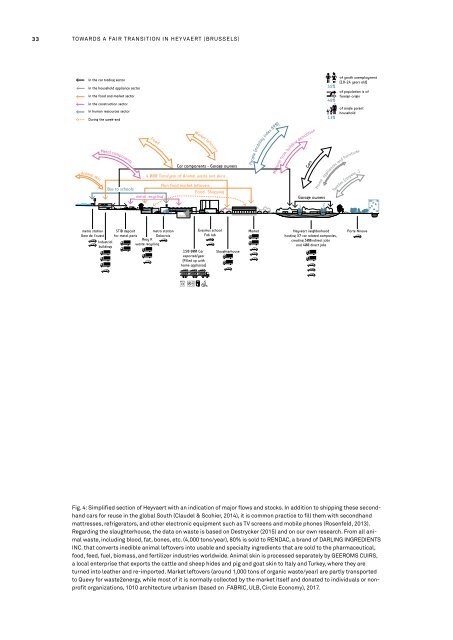DESIGNING TERRITORIAL METABOLISM
978-3-86859-489-8 https://www.jovis.de/de/buecher/product/designing_territorial_metabolism.html
978-3-86859-489-8
https://www.jovis.de/de/buecher/product/designing_territorial_metabolism.html
Create successful ePaper yourself
Turn your PDF publications into a flip-book with our unique Google optimized e-Paper software.
M<br />
M<br />
33<br />
Towards a Fair Transition in Heyvaert (Brussels)<br />
In the car trading sector<br />
In the household appliance sector<br />
In the food and market sector<br />
In the construction sector<br />
In human ressources sector<br />
During the week-end<br />
Animal skin<br />
Metal components<br />
Food<br />
Market leftovers<br />
Car components - Garage owners<br />
4 000 Tons/year of Animal waste and skins<br />
Non food market leftovers<br />
Bus to schools<br />
Food- Shopping<br />
metal recycling<br />
People (mobility index 89%)<br />
Cars<br />
Material from building demolition<br />
Home<br />
Garage owners<br />
55%<br />
48%<br />
13%<br />
of youth unemployment<br />
(18-24 years old)<br />
of population is of<br />
foreign origin<br />
of single parent<br />
household<br />
appliances and furnitures<br />
Textiles (carpets...)<br />
metro station<br />
Gare de l’ouest<br />
Industrial<br />
buildings<br />
STIB deposit<br />
for metal parts<br />
Recy K<br />
waste recycling<br />
metro station<br />
Delacroix<br />
150 000 Car<br />
exported/year<br />
(Filled up with<br />
home appliance)<br />
Erasmus school<br />
Fab lab<br />
Slaughterhouse<br />
Market<br />
Heyveart neighborhood<br />
hosting 37 car related companies,<br />
creating 500indirect jobs<br />
and 400 direct jobs<br />
Porte Ninove<br />
Fig. 4: Simplified section of Heyvaert with an indication of major flows and stocks. In addition to shipping these secondhand<br />
cars for reuse in the global South (Claudel & Scohier, 2014), it is common practice to fill them with secondhand<br />
mattresses, refrigerators, and other electronic equipment such as TV screens and mobile phones (Rosenfeld, 2013).<br />
Regarding the slaughterhouse, the data on waste is based on Destrycker (2015) and on our own research. From all animal<br />
waste, including blood, fat, bones, etc. (4,000 tons/year), 80% is sold to RENDAC, a brand of DARLING INGREDIENTS<br />
INC. that converts inedible animal leftovers into usable and specialty ingredients that are sold to the pharmaceutical,<br />
food, feed, fuel, biomass, and fertilizer industries worldwide. Animal skin is processed separately by GEEROMS CUIRS,<br />
a local enterprise that exports the cattle and sheep hides and pig and goat skin to Italy and Turkey, where they are<br />
turned into leather and re-imported. Market leftovers (around 1,000 tons of organic waste/year) are partly transported<br />
to Quevy for waste2energy, while most of it is normally collected by the market itself and donated to individuals or nonprofit<br />
organizations, 1010 architecture urbanism (based on .FABRIC, ULB, Circle Economy), 2017.


















